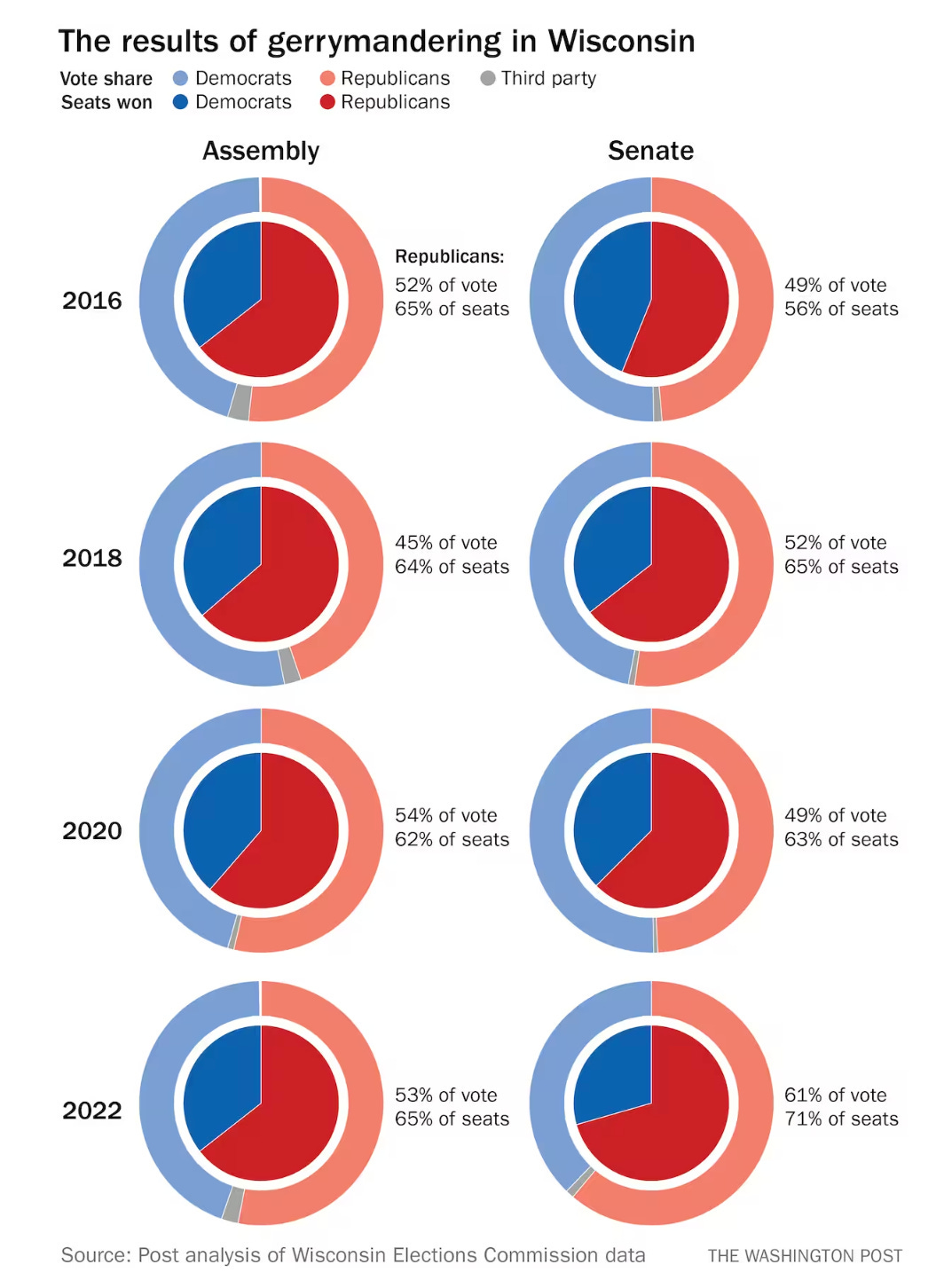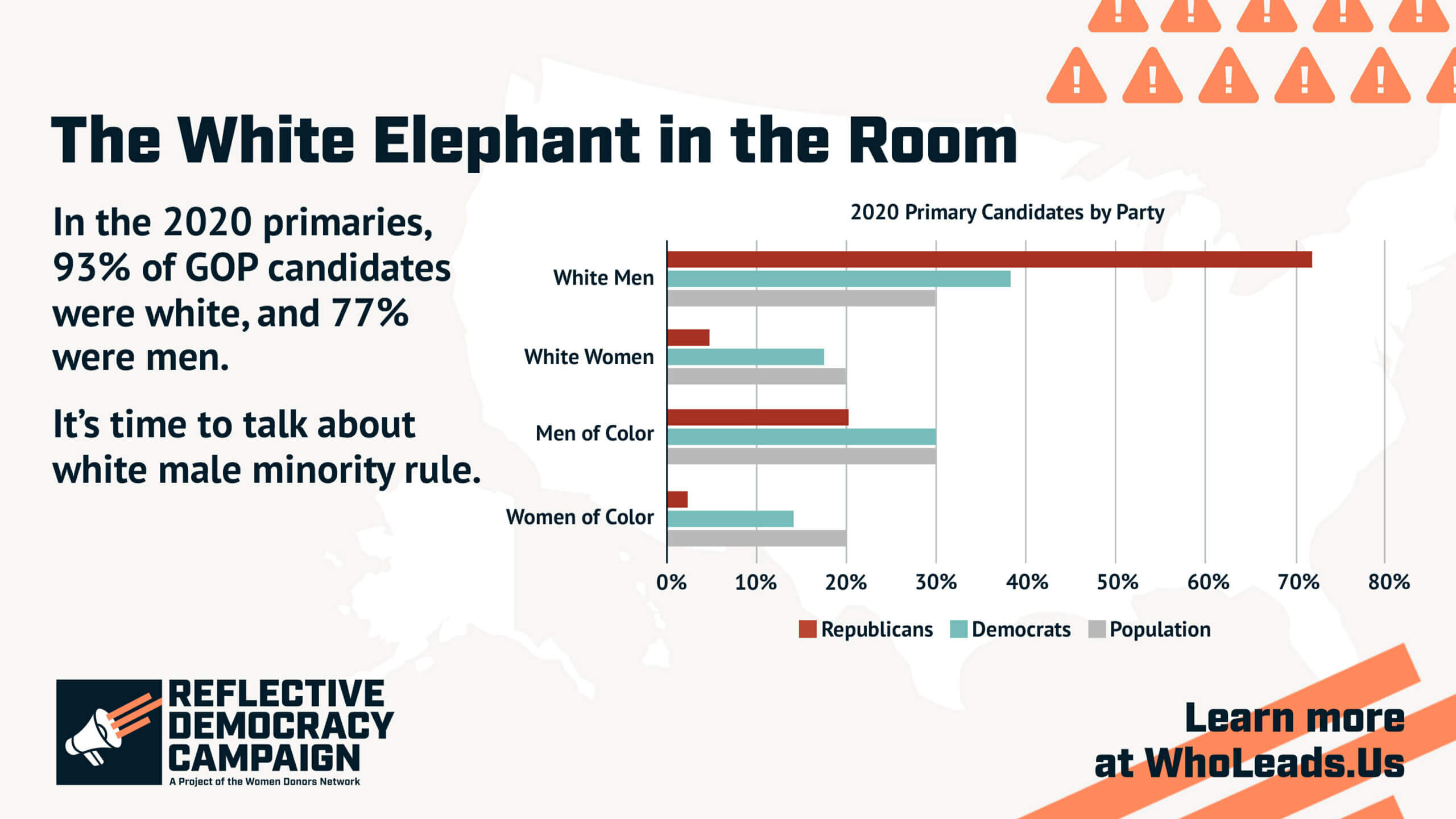Unrepresentative by Design & Neglect

House of Representatives
A Small and Divided Majority
The House Republican majority’s failure to avoid a government shutdown has been blamed on a small group of extremists, as few as five, who would rather tear down than build or govern. But as I began to research the topic, it seems that minority control of the Federal government has not only been long-lasting, but possibly by original design.
A full House has 435 voting members, making a majority (435-1)/2 +1 or 218 votes. Two seats are currently vacant and will be filled by special elections in November. This makes the current majority (433-1)/2 +1 or 217 votes.1 The Republicans have 221 members, but five Freedom Caucus members have voted against a Defense spending bill in a preliminary procedural rules vote, meaning the GOP has only 216 votes against a shutdown.2
Five Republicans willing to vote against their majority are holding the House and government hostage: Reps. Andy Biggs of Arizona, Dan Bishop of North Carolina, Ken Buck of Colorado, Ralph Norman of South Carolina, and Matt Rosendale of Montana.3
This faction of right-wing extremists is demanding that the Defense bill have provisions to limit abortion access, transgender medical treatment, and diversity efforts. “That’s not good legislation. And that’s blackmail,” House Rules Chair Tom Cole (R-OK) said.4
Gerrymanders
The House is supposed to be the more representative body in Congress, with the number of legislators proportional to state population and two-year terms. Even before the current Republican majority, though, the ghost of Elbridge Gerry was haunting the House and state legislatures.

Republicans in southern and midwestern states have gerrymandered House and state districts to win elections with a minority of the votes. In a Virginia state legislature election in 2017 Democrats cast 55% of the total state votes, but Republicans held control of the Assembly with 45%. Similar outcomes occurred in the House, where Democrats routinely outvote Republicans nationwide but Republicans win a majority by gerrymandering.5
Banning abortions and allowing adults to openly carry handguns without license or training do not have broad public support in Texas. But state legislators have created districts for themselves and Congress “behind closed doors, using highly sophisticated computer models,” that guarantee most incumbents will win general elections. Their only vulnerability is primary elections and “ideological purity … appealing to hard-core activists. Moderation is not a quality in high demand.” 6
This Washington Post graphic shows the results of gerrymandering in Wisconsin:

The Republican Party routinely loses statewide elections but has a supermajority in both the Assembly and state Senate. This representation has not changed, even for blue waves like 2018. Jamelle Bouie of the New York Times said:
The gerrymandering alone undermines Wisconsin’s status as a democracy. If a majority of people cannot, under any realistic circumstances, elect a legislative majority of their choosing, then it’s hard to say whether they actually govern themselves.
The U.S. Supreme Court has so far only reversed gerrymandering for racial imbalances, not political. The only hope for Wisconsin is the new state supreme court majority, which has Republican legislators threatening impeachment.7
Senate
Unrepresentative by Design
The Senate, on the other hand, is unrepresentative by design. The original Constitution of 1789 provided two senators for every state, to be selected by the state legislatures, for terms of 6 years.8 An unrepresentative number of representatives twice removed from the people. It wasn’t until the 17th Amendment in 1913 that senators were directly elected by the people of the states.9
Chief Justice Warren Burger explained that this “Great Compromise, under which one House was viewed as representing the people and the other the states, allayed the fears of both the large and small states.” Some scholars have argued that the Framers deliberately designed the lawmaking process to be slow and inefficient so that the laws that passed were sufficiently deliberative, representative, and accountable.10
… the Senate was never designed to be as democratic as the House. Since every state, regardless of its population, gets two votes in the Senate, it is the nation’s only legislative branch not organized along the principle of “one person, one vote.” The U.S. population continues to concentrate in urban and coastal areas, so the political imbalance grows. States representing 18 percent of the population now elect a majority of the Senate, as the Cook Political Report has pointed out.
“Five myths about the U.S. Senate,” The Washington Post, January 31, 202011
Filibusters & Holds
The Senate has added its own rules to further slow and obstruct legislation. Ending debate is an extreme measure for a group that likes to call itself “the world’s greatest deliberative body.”12 Rule XXII of the Standing Rules of the Senate requires a super majority of 60 votes (or two-thirds of senators present when amending rules) to stop.13 The Senate seems designed to do little, slowly.
Confirming presidential appointments is another practice the Senate carries to extremes. Even with GOP control of the House after 2022, Senate Democrats should have been able to confirm with a majority vote. But Tommy Tuberville (R-AL) has been holding hundreds of military appointments hostage for six months in an attempt to restrict abortions for military personnel.”14
Senate rules allow individual senators to require roll call rather than voice votes on every appointment or promotion in the military that the Senate reviews. Hundreds of roll call votes would prevent any other Senate work for months.15
A rule change preventing single-member obstruction would require only one majority vote,16 but Democrats have been unwilling to take that step.
Electoral College
The Electoral College was created as a compromise between two proposals for electing the president: a vote by Congress or a direct popular vote. The compromise called for each state legislature to appoint electors equal to the total of its senators and representatives, giving the least populous states 3 electors minimum. 48 of 50 states currently give the candidate receiving the most popular votes in the state all their electors.
State legislatures originally selected electors, but gradually changed to election by popular vote. Since 1860 all electors have been popularly chosen, and the Electoral College has elected the candidate who received the most popular votes in all but four elections: 1876, 1888, 2000, and 2016.17
In 2016 Trump lost the popular vote by more than 3 million but won the Electoral College with help from the 20 least populous states. Those 20 states have about the population of California, but get a total of 100 electoral votes to California’s 55.18
More than 700 Constitutional amendments have been proposed to change or eliminate the Electoral College, more than any other subject. A majority have favored abolishing it in public polls since 1967 and in the American Bar Association since 1987. Political scientists have supported continuing it, possibly because it discourages third parties.19
The Electoral College favors small, less populous states by giving their electoral votes to fewer people, decreasing equal voter representation, something the Senate already does. FairVote, The Center for Voting and Democracy, argues that the Electoral College both fails to protect state interests and succeeds in disenfranchising voters. It recommends that we make ‘one person one vote’ a reality by abolishing the Electoral College and directly electing the president.20
The structural features that make the Senate and Electoral College unrepresentative lead us to this quote and graphic from Jack Miller and Karim Douieb: “Land doesn’t vote. People do.”21
Voter Participation
Minority rule rises as voter participation falls. Nationally voter participation is less than 50% of the electorate in presidential elections and 30% in mid-terms. For special elections, it can drop to 10%. A small minority of the electorate, as little as 6% in a special election or primary, can pick the winner.22
These numbers show how 5% of all Texas voters can pick the winners by deciding GOP primaries:

Lower voter participation favors Republicans, who trend older and wealthier and vote more often. This is why Republicans try to suppress the vote, especially in urban areas favoring Democrats. This is why they require voter ID, reduce polling places, restrict early voting, and purge voter rolls, all without evidence of voter fraud.24
Between 2014 and 2016 over 16 million voters were purged from voting rolls and millions of others gave up trying to vote. Trump won the Presidency based on the electoral votes of three midwestern states that chose him by a total of 70,000 votes.25 Every vote can be incredibly important.
White Male Rule
If race and gender are considered, then minority rule gets even worse:
At just 30 percent of the population, white men exercise minority rule over 42 state legislatures, the House, the Senate, and statewide offices from coast to coast.
Reflective Democracy Campaign of the Women Donors Network, May 202126

Voters were restricted to white males who owned property for the first 81 years of the United States. Black men were given citizenship by the 14th Amendment in 1868 and the explicit right to vote by the 15th Amendment in 1870, but even then were prevented from voting by “poll taxes, literacy tests, fraud, and intimidation.”27 It took women 131 years to vote nationally with the 19th Amendment in 1920.28
The Women Donors Network blames incumbency and the GOP for this white male rule. Across all offices, 96% of incumbents win re-election. But 60% of all incumbents are white men. And in the 2020 primaries, 93% of GOP candidates were white, and 77% were men.29

To Do List
Our easiest solution to minority rule would be for more eligible voters to vote. Even if we don’t like the results, the arithmetic gives us more representation from more participation. Over time it can even reduce white male rule.
For the other problems we have this list:
- Gerrymanders should become extinct. If existing state legislators are unwilling to create representative districts, then state or Federal courts should give the job to independent commissions with public members and full transparency.
- The Senate doesn’t need rules to make acting harder. Supermajority votes, filibusters, and appointment holds should be abolished in favor of simple majority rule in this already unrepresentative body.
- A constitutional amendment to eliminate the Electoral College is a heavy lift, with the first obstacle an evenly divided Congress. But we deserve direct election of the president.
Footnotes
- “United States House of Representatives,” Wikipedia, retrieved 9/26/23 ↩︎
- Connor O’Brien, “Hardliners block defense spending bill as GOP civil war worsens,” Politico, 09/19/2023 ↩︎
- Connor O’Brien, “Hardliners block defense spending bill as GOP civil war worsens,” Politico, 09/19/2023 ↩︎
- Connor O’Brien, “Hardliners block defense spending bill as GOP civil war worsens,” Politico, 09/19/2023 ↩︎
- D.J. Ford,”Minority Rule: How Republicans Took Control of the Federal Government with 25% of the Electorate,” Daily Kos, September 12, 2018 ↩︎
- Michael Hardy, “Minority Rule: How 3 Percent of Texans Call the Shots for the Rest of Us,” November 2022 ↩︎
- Don Moynihan, “The heads-I-win, tails-you-lose democracy,” Can We Still Govern? Sep 15, 2023 ↩︎
- Article I Section 3, “The Constitution of the United States: A Transcription,” National Archives, retrieved 9/27/23 ↩︎
- “The Constitution: Amendments 11-27,” National Archives, retrieved 9/27/23 ↩︎
- “Art I. S1.2.3 The Great Compromise of the Constitutional Convention,” Cornell Legal Information Institute, retrieved 9/27/23 ↩︎
- Kathy Kiely, “Five myths about the U.S. Senate,” The Washington Post, January 31, 2020 ↩︎
- Kathy Kiely, “Five myths about the U.S. Senate,” The Washington Post, January 31, 2020 ↩︎
- “Standing Rules of the Senate,” U.S. Government Printing Office, Revised To January 24, 2013 ↩︎
- Jay Kuo, “It’s Even Worse Than Minority Rule Now,” The Big Picture, Sep 26, 2023 ↩︎
- Jay Kuo, “It’s Even Worse Than Minority Rule Now,” The Big Picture, Sep 26, 2023 ↩︎
- Jay Kuo, “It’s Even Worse Than Minority Rule Now,” The Big Picture, Sep 26, 2023 ↩︎
- “United States Electoral College,” Wikipedia, retrieved 9/28/23 ↩︎
- D.J. Ford,”Minority Rule: How Republicans Took Control of the Federal Government with 25% of the Electorate,” Daily Kos, September 12, 2018 ↩︎
- “Electoral College History,” National Archives, retrieved 9/28/23 ↩︎
- “The Electoral College,” FairVote, retrieved 9/28/23 ↩︎
- Karim Douïeb (@karim_douieb) and Jack Miller (@politicalmiller), “Land doesn’t vote. People do.” Imgur image, retrieved 9/28/23 ↩︎
- D.J. Ford,”Minority Rule: How Republicans Took Control of the Federal Government with 25% of the Electorate,” Daily Kos, September 12, 2018 ↩︎
- Michael Hardy, “Minority Rule: How 3 Percent of Texans Call the Shots for the Rest of Us,” November 2022 ↩︎
- D.J. Ford,”Minority Rule: How Republicans Took Control of the Federal Government with 25% of the Electorate,” Daily Kos, September 12, 2018 ↩︎
- D.J. Ford,”Minority Rule: How Republicans Took Control of the Federal Government with 25% of the Electorate,” Daily Kos, September 12, 2018 ↩︎
- “System Failure: What the 2020 Primary Elections revealed about our democracy,” Women Donors Network, May 2021 ↩︎
- “Voting Rights for African Americans,” Library of Congress, retrieved 9/28/23 ↩︎
- “The Constitution: Amendments 11-27,” National Archives, retrieved 9/27/23 ↩︎
- “System Failure: What the 2020 Primary Elections revealed about our democracy,” Women Donors Network, May 2021 ↩︎

Reply
You must be logged in to post a comment.